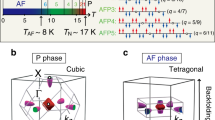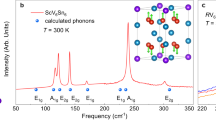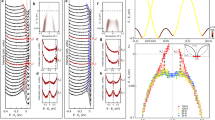Abstract
Rare-earth intermetallic compounds exhibit rich phenomena induced by the interplay between localized f orbitals and conduction electrons. However, since the energy scale of the crystal-electric-field splitting is only a few millielectronvolts, the nature of the mobile electrons accompanied by collective crystal-electric-field excitations has not been unveiled. Here, we examine the low-energy electronic structures of CeSb through the anomalous magnetostructural transitions below the Néel temperature, ~17 K, termed the ‘devil’s staircase’, using laser angle-resolved photoemission, Raman and neutron scattering spectroscopies. We report another type of electron–boson coupling between mobile electrons and quadrupole crystal-electric-field excitations of the 4f orbitals, which renormalizes the Sb 5p band prominently, yielding a kink at a very low energy (~7 meV). This coupling strength is strong and exhibits anomalous step-like enhancement during the devil’s staircase transition, unveiling a new type of quasiparticle, named the ‘multipole polaron’, comprising a mobile electron dressed with a cloud of the quadrupole crystal-electric-field polarization.
This is a preview of subscription content, access via your institution
Access options
Access Nature and 54 other Nature Portfolio journals
Get Nature+, our best-value online-access subscription
$29.99 / 30 days
cancel any time
Subscribe to this journal
Receive 12 print issues and online access
$259.00 per year
only $21.58 per issue
Buy this article
- Purchase on Springer Link
- Instant access to full article PDF
Prices may be subject to local taxes which are calculated during checkout




Similar content being viewed by others
Data availability
The data that support the findings of this study are available from the corresponding author upon request.
References
Reznik, D. et al. Electron–phonon coupling reflecting dynamic charge inhomogeneity in copper oxide superconductors. Nature 440, 1170–1173 (2006).
Teresa, J. M. D. et al. Evidence for magnetic polarons in the magnetoresistive perovskites. Nature 386, 256–259 (1997).
Millis, A. J. Lattice effects in magnetoresistive manganese perovskites. Nature 392, 147–150 (1998).
Devreese, J. T. Polarons in Digital Encyclopedia of Applied Physics (Wiley VHC Verlag, 2003) https://doi.org/10.1002/3527600434.eap347
Damascelli, A., Hussain, Z. & Shen, Z.-X. Angle-resolved photoemission studies of the cuprate superconductors. Rev. Mod. Phys. 75, 473–541 (2003).
Valla, T., Fedorov, A. V., Johnson, P. D. & Hulbert, S. L. Many-body effects in angle-resolved photoemission: quasiparticle energy and lifetime of a Mo(110) surface state. Phys. Rev. Lett. 83, 2085–2088 (1999).
Lanzara, A. et al. Evidence for ubiquitous strong electron–phonon coupling in high-temperature superconductors. Nature 412, 510–514 (2001).
Schäfer, J. et al. Electronic quasiparticle renormalization on the spin wave energy scale. Phys. Rev. Lett. 92, 097205 (2004).
Dahm, T. et al. Strength of the spin-fluctuation-mediated pairing interaction in a high-temperature superconductor. Nat. Phys. 5, 217–221 (2009).
Bostwick, A. et al. Observation of plasmarons in quasi-freestanding doped graphene. Science 328, 999–1002 (2010).
Bak, P. The devil’s staircase. Phys. Today 39, 38–45 (1986).
Rossat-Mignod, J. et al. Phase diagram and magnetic structures of CeSb. Phys. Rev. B 16, 440–461 (1977).
Fischer, P., Meier, G., Lebech, B., Rainford, B. D. & Vogt, O. Magnetic phase transitions of CeSb. I. Zero applied magnetic field. J. Phys. C 11, 345–364 (1978).
Rossat-Mignod, J., Burlet, P., Bartholin, H., Vogt, O. & Lagnier, R. Specific heat analysis of the magnetic phase diagram of CeSb. J. Phys. C 13, 6381–6389 (1980).
Hulliger, F., Landolt, M., Ott, H. & Schmelczer, R. Low-temperature magnetic phase transitions of CeBi and CeSb. J. Low Temp. Phys. 20, 269–284 (1975).
Iwasa, K., Hannan, A., Kohgi, M. & Suzuki, T. Direct observation of the modulation of the 4f-electron orbital state by strong p–f mixing in CeSb. Phys. Rev. Lett. 88, 207201 (2002).
Mori, N., Okayama, Y., Takahashi, H., Kwon, Y. & Suzuki, T. Pressure-induced electrical and magnetic properties in CeAs, CeSb and CeBi. J. Appl. Phys. 69, 4696–4698 (1991).
Ye, L., Suzuki, T., Wicker, C. R. & Checkelsky, J. G. Extreme magnetoresistance in magnetic rare-earth monopnictides. Phys. Rev. B 97, 081108 (2018).
Xu, J. et al. Orbital-flop induced magnetoresistance anisotropy in rare earth monopnictide CeSb. Nat. Commun. 10, 2875 (2019).
Kumigashira, H. et al. Paramagnetic-to-antiferroparamagnetic phase transition of CeSb studied by high-resolution angle-resolved photoemission. Phys. Rev. B 56, 13654 (1997).
Takayama, A., Souma, S., Sato, T., Arakane, T. & Takahashi, T. Magnetic phase transition of CeSb studied by low-energy angle-resolved photoemission spectroscopy. J. Phys. Soc. Jpn 78, 073702 (2009).
Jang, S. et al. Direct visualization of coexisting channels of interaction in CeSb. Sci. Adv. 5, eaat7158 (2019).
Kuroda, K. et al. Devil’s staircase transition of the electronic structures in CeSb. Nat. Commun. 11, 2888 (2020).
Nishi, T. et al. Infrared spectroscopy under multiextreme conditions: direct observation of pseudogap formation and collapse in CeSb. Phys. Rev. B 71, 220401 (2005).
Takahashi, H. & Kasuya, T. Anisotropic p-f mixing mechanism explaining anomalous magnetic properties in Ce monopnictides. V. Various ordered states and phase diagrams. J. Phys. C 18, 2745 (1985).
Kasuya, T. Physics in low carrier strongly correlated systems: Kondo insulator magnetic polaron and high Tc. Physica B 215, 88–98 (1995).
Shimojima, T., Okazaki, K. & Shin, S. Low-temperature and high-energy-resolution laser photoemission spectroscopy. J. Phys. Soc. Jpn 84, 072001 (2015).
Yeh, J. & Lindau, I. Atomic subshell photoionization cross sections and asymmetry parameters: 1 ⩽ Z ⩽ 103. At. Data Nucl. Data Tables 32, 1–155 (1985).
Kawamura, M., Hizume, Y. & Ozaki, T. Benchmark of density functional theory for superconductors in elemental materials. Phys. Rev. B 101, 134511 (2020).
Tütüncü, H. M., Bagci, S. & Srivastava, G. P. Electronic, elastic and phonon properties of the rock-salt LaSb and YSb. J. Phys. Condens. Matter 19, 156207 (2007).
Rossat-Mignod, J. et al. Neutron and magnetization studies of CeSb and CeSb1–xTex solid solutions. J. Magn. Magn. Mater. 52, 111–121 (1985).
Hälg, B. & Furrer, A. Anisotropic exchange and spin dynamics in the type-I (-IA) antiferromagnets CeAs, CeSb, and USb: a neutron study. Phys. Rev. B 34, 6258–6279 (1986).
Thalmeier, P. & Lüthi, B. in Handbook on the Physics and Chemistry of Rare Earths, Vol. 14 (eds Gschneidner Jr, K. A. & Eyring, L.) Ch. 96 (Elsevier, 1991).
Iwasa, K. et al. Crystal-lattice modulation and phonon anomaly associated with strong p–f mixing effect of CeSb. Appl. Phys. A 74, s1779–s1781 (2002).
Güntherodt, G., Jayaraman, A., Batlogg, G., Croft, M. & Melczer, E. Raman scattering from coupled phonon and electronic crystal-field excitations in CeAl2. Phys. Rev. Lett. 51, 2330–2332 (1983).
Sethi, A., Slimak, J. E., Kolodiazhnyi, T. & Cooper, S. L. Emergent vibronic excitations in the magnetodielectric regime of Ce2O3. Phys. Rev. Lett. 122, 177601 (2019).
Wang, Z. et al. Tailoring the nature and strength of electron–phonon interactions in the SrTiO3(001) 2d electron liquid. Nat. Mater. 15, 835–839 (2016).
Verdi, C., Caruso, F. & Giustino, F. Origin of the crossover from polarons to Fermi liquids in transition metal oxides. Nat. Commun. 8, 15769 (2017).
Suzuki, T. et al. Anomalous physical properties of the low carrier concentration state in f-electron systems. Physica B Condens. Matter 206–207, 771–779 (1995).
Pfleiderer, C. Superconducting phases of f-electron compounds. Rev. Mod. Phys. 81, 1551–1624 (2009).
Li, H. et al. Coherent organization of electronic correlations as a mechanism to enhance and stabilize high-TC cuprate superconductivity. Nat. Commun. 9, 26 (2018).
Cuk, T. et al. Coupling of the B1g phonon to the antinodal electronic states of Bi2Sr2Ca0.92Y0.08Cu2O8+δ. Phys. Rev. Lett. 93, 117003 (2004).
Fobes, D. M. et al. Tunable emergent heterostructures in a prototypical correlated metal. Nat. Phys. 14, 456–460 (2018).
Kuroda, K. et al. Experimental determination of the topological phase diagram in cerium monopnictides. Phys. Rev. Lett. 120, 086402 (2018).
Kusunose, H. Description of multipole in f-electron systems. J. Phys. Soc. Jpn 77, 064710 (2008).
Katakura, I. et al. Development of high-speed polarizing imaging system for operation in high pulsed magnetic field. Rev. Sci. Instrum. 81, 043701 (2010).
Giannozzi, P. et al. Advanced capabilities for materials modelling with quantum ESPRESSO. J. Phys. Condens. Matter 29, 465901 (2017).
Giannozzi, P. et al. QUANTUM ESPRESSO: a modular and open-source software project for quantum simulations of materials. J. Phys. Condens. Matter 21, 395502 (2009).
Samsonov, G. V., Abdusalyamova, M. N., Shokirov, K. & Pryakhina, S. A. Physico-chemical properties of rare earth monoantimonides. Izv. Akad. Nauk SSSR, Neorg. Mater. 10, 1951–1954 (1974).
Hamann, D. R. Optimized norm-conserving Vanderbilt pseudopotentials. Phys. Rev. B 88, 085117 (2013).
Scherpelz, P., Govoni, M., Hamada, I. & Galli, G. Implementation and validation of fully relativistic GW calculations: spin–orbit coupling in molecules, nanocrystals, and solids. J. Chem. Theory Comput. 12, 3523–3544 (2016).
Perdew, J. P., Burke, K. & Ernzerhof, M. Generalized gradient approximation made simple. Phys. Rev. Lett. 77, 3865–3868 (1996).
Baroni, S., de Gironcoli, S., Dal Corso, A. & Giannozzi, P. Phonons and related crystal properties from density-functional perturbation theory. Rev. Mod. Phys. 73, 515–562 (2001).
Acknowledgements
We acknowledge H. Kusunose, M. Kawamura and S. Tsutsui for fruitful discussions, and M. Kohgi, J.-M. Mignot and M. Braden for support of the INS experiments. This work was supported by Japan’s Ministry of Education, Culture, Sports, Science and Technology’s Quantum Leap Flagship Program (MEXT Q-LEAP, grant number JPMXS0118068681), the Ministry of Education, Culture, Sports, Science and Technology’s ‘Program for Promoting Researches on the Supercomputer Fugaku’ (Basic Science for Emergence and Functionality in Quantum Matter Innovative Strongly Correlated Electron Science by Integration of ‘Fugaku’ and Frontier Experiments, project number hp200132), JST ERATO-FS grant number JPMJER2105, the Murata Science Foundation, Grants-in-Aid for Scientific Research (grant numbers JP21H04439, JP20H01848, JP19H00651, JP19H02683, JP19F19030, JP18H01165, JP18H01182A and JP16H06345) and Grants-in-Aids for Scientific Research on Innovative Areas, ‘Quantum Liquid Crystals’ (grant number 19H05825) from the Ministry of Education, Culture, Sports, Science, and Technology of Japan.
Author information
Authors and Affiliations
Contributions
Y.A. and K. Kuroda performed the laser ARPES experiments and analysed the data. S. Sakuragi, C.B., S.A., K. Kurokawa, S. Shin and T.K. supported the laser ARPES experiments. Y.A., K. Kuroda, S. Sakuragi, W.-L.Z., Z.H.T., S.M. and S.T. conducted the Raman spectroscopy and analysed the data. H.S.S., H.K. and Y.H. made the high-quality CeSb single crystals. Y.A., K. Kuroda., S. Sakuragi, Y.K. and M.T. performed the polarizing microscopy. K.I. performed the neutron scattering spectroscopy. T.N. and R.A. provided theoretical insights. Y.A., K. Kuroda and T.K. wrote the paper. All authors discussed the results and commented on the manuscript.
Corresponding author
Ethics declarations
Competing interests
The authors declare no competing interests.
Peer review
Peer review information
Nature Materials thanks Jonathan Denlinger, Jian-Xin Zhu and the other, anonymous, reviewer(s) for their contribution to the peer review of this work.
Additional information
Publisher’s note Springer Nature remains neutral with regard to jurisdictional claims in published maps and institutional affiliations.
Supplementary information
Supplementary Information
Supplementary Notes 1–6 and Figs. 1–7.
Rights and permissions
About this article
Cite this article
Arai, Y., Kuroda, K., Nomoto, T. et al. Multipole polaron in the devil’s staircase of CeSb. Nat. Mater. 21, 410–415 (2022). https://doi.org/10.1038/s41563-021-01188-9
Received:
Accepted:
Published:
Issue Date:
DOI: https://doi.org/10.1038/s41563-021-01188-9
This article is cited by
-
Laser-based angle-resolved photoemission spectroscopy with micrometer spatial resolution and detection of three-dimensional spin vector
Scientific Reports (2024)
-
Spin-orbital Jahn-Teller bipolarons
Nature Communications (2024)
-
Antiferromagnetic topological insulator with selectively gapped Dirac cones
Nature Communications (2023)
-
Multipole polaron roams the devil’s staircase
Nature Materials (2022)



